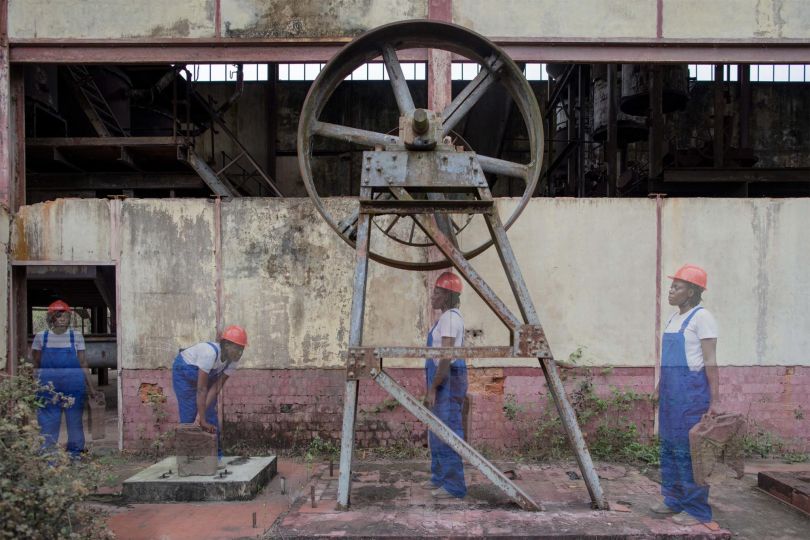Charles Nègre left Paris for Provence and a journey of nearly six months. In the summer of 1852, he was 32 years old and had an unwavering faith in his work. It takes a lot to embark, as an author, in the somewhat crazy project of a photographic inventory of the “South of France”. This will be the title of the album he hopes to have released on his return. Because, even before leaving, his innovative spirit contemplated the edition of photographic plates which would tell the treasures of his native region.
Of course he is not the first. In 1850 Maxime Du Camp, accompanied by Gustave Flaubert, made a trip to Egypt, the album had some success. Blanquart-Evrard, in 1851, created in Loos near Lille a photographic printing press which facilitated the multiplication of prints to constitute commercial albums.
But Charles Nègre very early on joined this movement in favor of a wide distribution of photographs, the opposite of painting which sanctifies the unique work. For the time, it was a revolution in mentalities, and allowed a greater number of people to have access to art – in any case to documentation in images – proceeded from a modern spirit that few shared.
Charles Nègre recounts: “… It is not only the picturesque and varied nature of the sites, the radiance of the sun, the purity of the atmosphere that I wanted to reproduce in my Photographed views; beside these beauties with which the creator has endowed our southern countries and which are due to entirely physical causes, I have looked for beauties of another order which must also interest us because they relate to the study of art and history ….. I explored Avignon, Arles, Saint-Gilles, les Beaux, Tarascon, Beaucaire, Aix, Fréjus, Marseille, Toulon, etc. ” in his Manuscript for an introductory project for the album Midi de la France, cited by James Borcoman, “Charles Nègre 1820-1880” [National Gallery of Canada, Ottawa in 1976].
We can add to this trip the eastern part of Provence, with Grasse of course, where he meet up with his family, and the surroundings, Saint-Cézaire, Cannes, Antibes …
On June 10, 1854, the review “La Lumière”, the press organ of the Société Héliographique, announced the publication by Goupil & Vibert of the first plates from Charles Nègre’s trip. But the full edition of the album was a commercial failure despite the great wealth of photographs taken. Two series of five proofs were printed by the H. de Fonteny photographic printing press, while the set was supposed to include twelve.
Potential clients, wealthy bourgeois of the Second Empire, hesitated to spend large enough sums of money on albums in which the images, composed of silver salts, faded in the light in a relatively short period of time.
In fact, Charles Nègre understood everything and transformed this powerlessness into a force that would push him to work hard, from 1854, to develop heliographic engraving, a printing process that would perpetuate photographs. But this is the beginning of another story …
Michel Cresp

![Les Arènes d'Arles, côté sud [Le Midi de la France] © 1852 Charles Nègre collection Musée d'Art et d'Histoire de Provence](https://cdn.loeildelaphotographie.com/wp-content/uploads/2021/04/01-les-arenes-darles-cote-sud-le-midi-de-la-france-1852-charles-negre-collection-musee-dart-et-dhistoire-de-provence-x540q80.jpg)
![La Porte des Chataîgnes, Arles [Le Midi de la France] © 1852 Charles Nègre collection Musée d'Art et d'Histoire de Provence](https://cdn.loeildelaphotographie.com/wp-content/uploads/2021/04/02-la-porte-des-chataignes-arles-le-midi-de-la-france-1852-charles-negre-collection-musee-dart-et-dhistoire-de-provence-x540q80.jpg)
![Deux arlésiennes dans le cloître Saint-Trophime, Arles [Le Midi de la France] © 1852 Charles Nègre collection particulière, tirage moderne Michel Cresp](https://cdn.loeildelaphotographie.com/wp-content/uploads/2021/04/03-deux-arlesiennes-dans-le-cloitre-saint-trophime-arles-le-midi-de-la-france-1852-charles-negre-collection-particuliere-tirage-moderne-michel-cresp-x540q80.jpg)
![Les Alyscamps, chapelle Saint-Accurse, Arles [Le Midi de la France] © 1852 Charles Nègre courtesy André Jammes](https://cdn.loeildelaphotographie.com/wp-content/uploads/2021/04/04-les-alyscamps-chapelle-saint-accurse-arles-le-midi-de-la-france-1852-charles-negre-courtesy-andre-jammes-x540q80.jpg)
![Le Château de Tarascon [Le Midi de la France] © 1852 Charles Nègre courtesy The Paul Getty Museum, USA](https://cdn.loeildelaphotographie.com/wp-content/uploads/2021/04/05-le-chateau-de-tarascon-le-midi-de-la-france-1852-charles-negre-courtesy-the-paul-getty-museum-usa-x540q80.jpg)
![La Poterne de l'abbaye, Montmajour [Le Midi de la France] © 1852 Charles Nègre collection Musée d'Orsay](https://cdn.loeildelaphotographie.com/wp-content/uploads/2021/04/06-la-poterne-de-labbaye-montmajour-le-midi-de-la-france-1852-charles-negre-collection-musee-dorsay-x540q80.jpg)
![Le Bassin de carénage, Marseille [Le Midi de la France] © 1852 Charles Nègre courtesy André Jammes](https://cdn.loeildelaphotographie.com/wp-content/uploads/2021/04/07-le-bassin-de-carenage-marseille-le-midi-de-la-france-1852-charles-negre-courtesy-andre-jammes-x540q80.jpg)
![Pins d'Italie sur la plage de Golfe-Juan Pins [Le Midi de la France] © 1852 Charles Nègre courtesy Archives Communales de Grasse](https://cdn.loeildelaphotographie.com/wp-content/uploads/2021/04/8-08-pins-ditalie-sur-la-plage-de-golfe-juan-pins-le-midi-de-la-france-1852-charles-negre-courtesy-archives-communales-de-grasse-x540q80.jpg)
![La Chapelle Saint-Pierre, Cannes [Le Midi de la France] © 1852 Charles Nègre courtesy Archives Communales de Grasse](https://cdn.loeildelaphotographie.com/wp-content/uploads/2021/04/9-09-la-chapelle-saint-pierre-cannes-le-midi-de-la-france-1852-charles-negre-courtesy-archives-communales-de-grasse-x540q80.jpg)
![Deux cueilleuses, Grasse [Le Midi de la France] © 1852 Charles Nègre courtesy Archives Communales de Grasse](https://cdn.loeildelaphotographie.com/wp-content/uploads/2021/04/10-10-deux-cueilleuses-grasse-le-midi-de-la-france-1852-charles-negre-courtesy-archives-communales-de-grasse-x540q80.jpg)
![La Montée Font Laugière, Grasse [Le Midi de la France] © 1852 Charles Nègre courtesy Archives Communales de Grasse](https://cdn.loeildelaphotographie.com/wp-content/uploads/2021/04/11-la-montee-font-laugiere-grasse-le-midi-de-la-france-1852-charles-negre-courtesy-archives-communales-de-grasse-x540q80.jpg)
![Le Citronnier, Grasse [Le Midi de la France] © 1852 Charles Nègre collection Musée d'Art et d'Histoire de Provence](https://cdn.loeildelaphotographie.com/wp-content/uploads/2021/04/12-12-le-citronnier-grasse-le-midi-de-la-france-1852-charles-negre-collection-musee-dart-et-dhistoire-de-provence-x540q80.jpg)
![La Place aux Aires, Grasse [Le Midi de la France] © 1852 © Charles Nègre collection Musée d'Orsay](https://cdn.loeildelaphotographie.com/wp-content/uploads/2021/04/13-13-la-place-aux-aires-grasse-le-midi-de-la-france-1852-charles-negre-collection-musee-dorsay-x540q80.jpg)
![Les Puits de la Vierge, Saint-Cézaire [Le Midi de la France] © 1852 Charles Nègre collection Musée d'Art et d'Histoire de Provence](https://cdn.loeildelaphotographie.com/wp-content/uploads/2021/04/14-les-puits-de-la-vierge-saint-cezaire-le-midi-de-la-france-1852-charles-negre-collection-musee-dart-et-dhistoire-de-provence-x540q80.jpg)
![Village de Saint-Cézaire-sur-Siagne [Le Midi de la France] © 1852 Charles Nègre - Repro Archives Communales de Grasse](https://cdn.loeildelaphotographie.com/wp-content/uploads/2021/04/15-village-de-saint-cezaire-sur-siagne-le-midi-de-la-france-1852-charles-negre-repro-archives-communales-de-grasse-x540q80.jpg)














